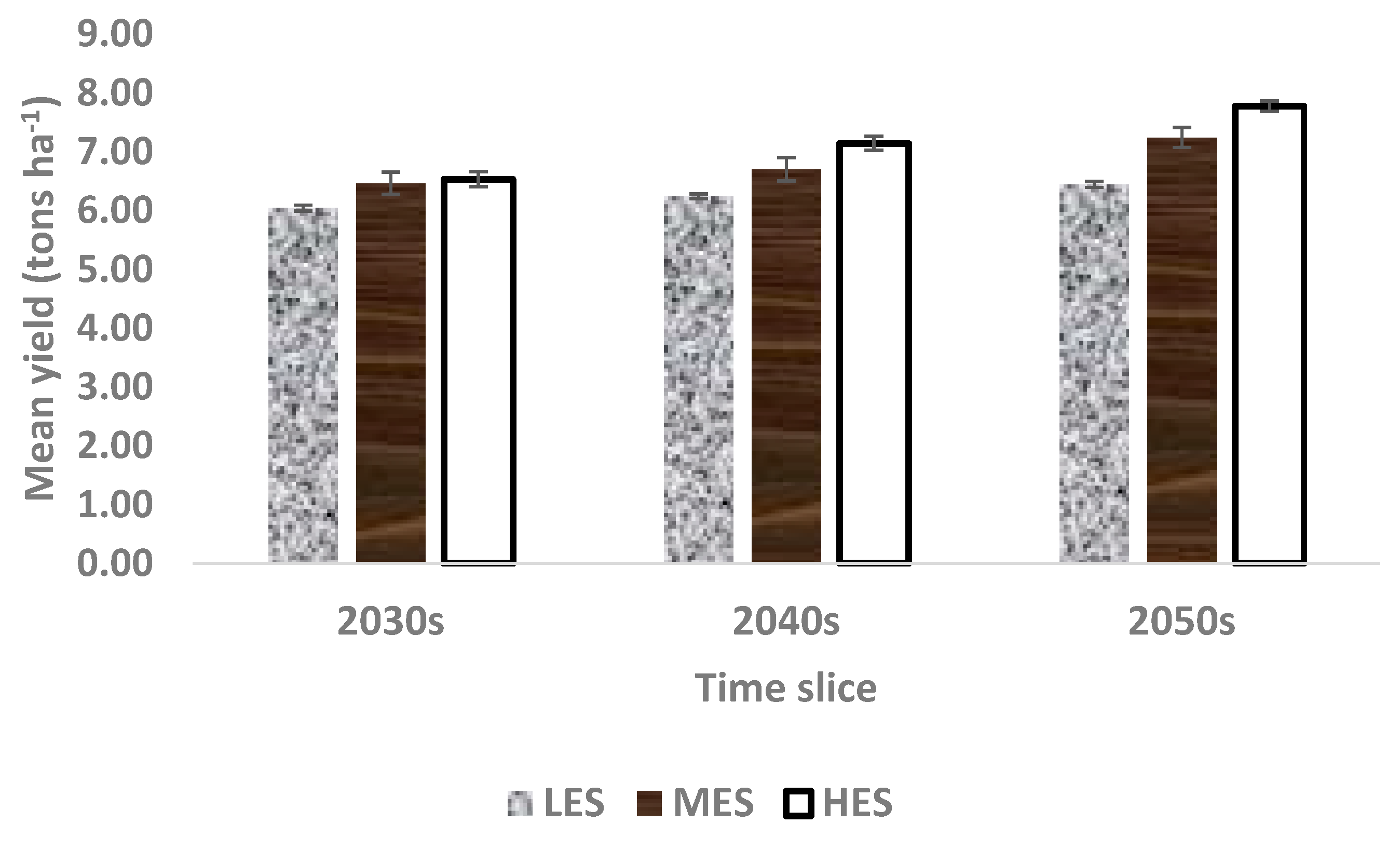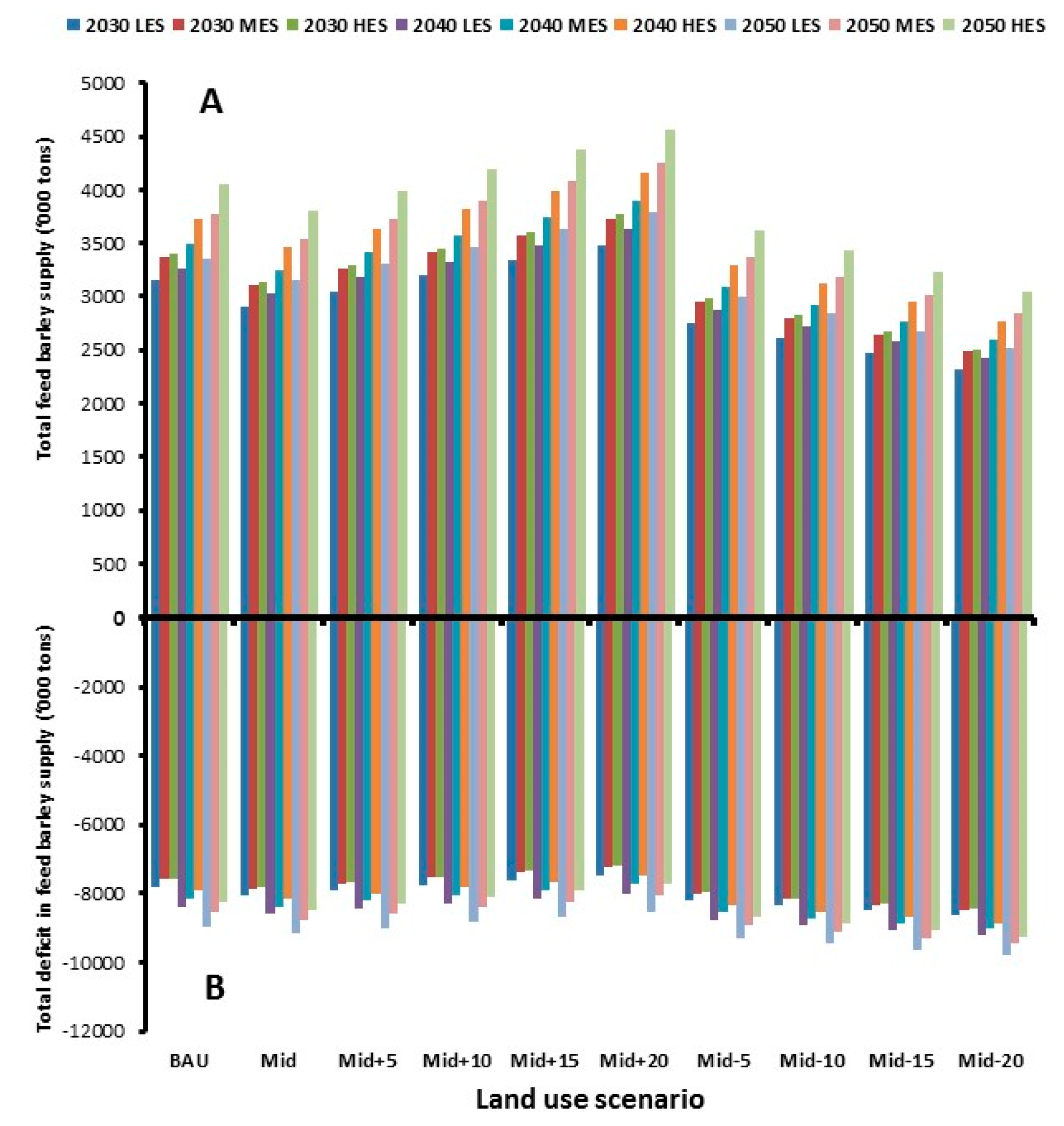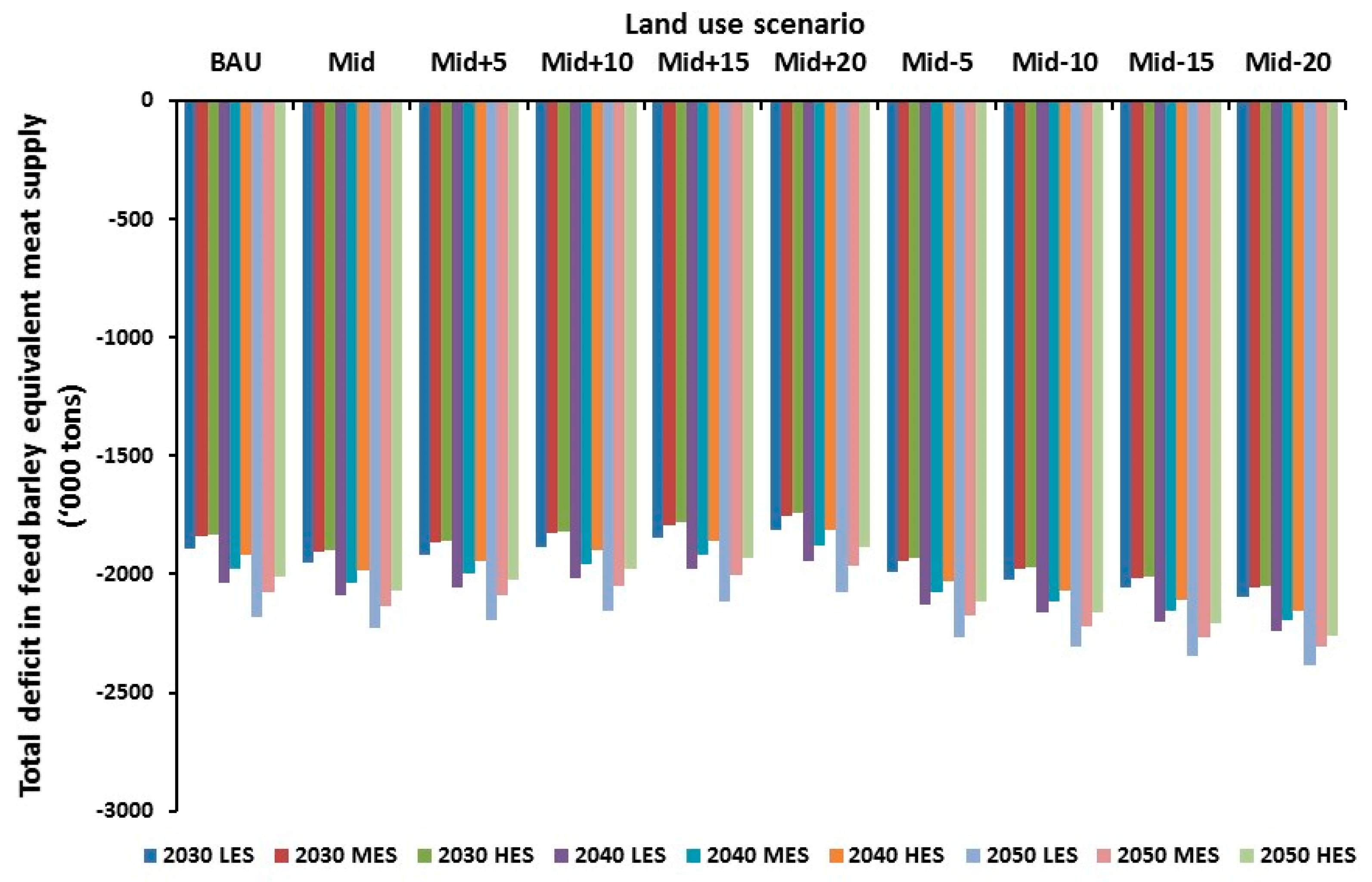Effect of Climate and Agricultural Land Use Changes on UK Feed Barley Production and Food Security to the 2050s
Abstract
:1. Introduction
2. Materials and Methods
2.1. Current Barley and Meat Indices
2.2. The Future Situation
2.2.1. Climate Change and Barley Grain Yields
2.2.2. Land Use Change and Barley Production
2.2.3. Demand for Feed Barley and Meat
3. Results
3.1. Projected Barley Grain Yields
3.2. Projected Land Areas and Barley Supply for Domestic Use
3.3. Projected Feed Barley and Meat Demand
4. Discussion
4.1. Deficits in Feed Barley or Feed Barley Equivalent Meat Supply
4.2. Limitations to the Study
5. Conclusions
Acknowledgments
Author Contributions
Conflicts of Interest
References
- Department of Environment, Food and Rural Affairs Family Food 2012; National Statistics Publication for DEFRA, Department of Environment, Food and Rural Affairs: London, UK, December 2013. Available online: www.gov.uk/government/collections/family-food-statistics (accessed on 29 January 2014).
- Foresight. The Future of Food and Farming: Challenges and Choices for Global Sustainability; Final Project Report; The Government Office for Science: London, UK, 2011.
- Chakraborty, S.; Newton, A.C. Climate change, plant diseases and food security, an overview. Plant Pathol. 2011, 60, 2–14. [Google Scholar] [CrossRef]
- Newton, A.C.; Flavell, A.J.; George, T.S.; Leat, P.; Mulholland, B.; Ramsay, L.; Revoredo-Giha, C.; Russell, J.; Steffenson, B.J.; Swanston, J.S.; et al. Crops that feed the world 4. Barley: A resilient crop? Strengths and weaknesses in the context of food security. Food Secur. 2011, 3, 141–178. [Google Scholar] [CrossRef]
- Alexandratos, N.; Bruinsma, J. World Agriculture towards 2030/2050: The 2012 Revision; ESA Working Paper, No. 12-03; Food and Agriculture Organization: Rome, Italy, 2012. [Google Scholar]
- De Fraiture, C.; Wichelns, D.; Rockström, J.; Kemp-Benedict, E.; Eriyagama, N.; Gordon, L.J.; Hanjra, M.A.; Hoogeveen, J.; Huber-Lee, A.; Karlberg, L. Looking ahead to 2050: Scenarios of alternative investment approaches. In Water for Food, Water for Life: A Comprehensive Assessment of Water Management in Agriculture; Molden, D., Ed.; Earthscan: London, UK, 2007; pp. 91–145. [Google Scholar]
- Bruinsma, J. European and Central Asian Agriculture towards 2030 and 2050; Policy Studies on Rural Transition No. 2012-1; FAO Regional Office for Europe and Central Asia: Rome, Italy, 2012. [Google Scholar]
- Kruse, J. Estimating Demand for Agricultural Commodities to 2050; Report No. 3-16-10; Global Harvest Initiative: Washington, DC, USA, 2011; Available online: http://www.globalharvestinitiative.org/Documents/Kruse%20-%20Demand%20for%20Agricultural%20Commoditites.pdf (accessed on 23 July 2013).
- Defra. Agriculture in the United Kingdom (2011); Department of Environment, Food and Rural Affairs: London, UK, 2011.
- Food and Agriculture Organization of the United Nations. Livestock: Primary; FAOSTAT Data for the UK; Food and Agriculture Organization of the United Nations: Rome, Italy, 2017; Available online: http://www.fao.org/faostat/en/#data/QL (accessed on 5 September 2017).
- European Commission. Prospects for agricultural markets and income in the EU 2011–2020. European Commission, Directorate for Agriculture and Rural Development. 2011. Available online: http://ec.europa.eu/agriculture/publi/caprep/prospects2011/fullrep_en.pdf (accessed on 7 January 2015).
- FAO. Planning for Sustainable Use of Land Resources; FAO Land and Water Bulletin 2; Food and Agriculture Organization of the United Nations: Rome, Italy, 1995. [Google Scholar]
- Department of Environment, Food and Rural Affairs. Farming Statistics: Final Crop Areas, Yields, Livestock Populations and Agricultural Workforce at June 2016—United Kingdom; Department of Environment, Food and Rural Affairs: London, UK. Available online: https://www.gov.uk/government/uploads/system/uploads/attachment_data/file/579402/structure-jun2016final-uk-20dec16.pdf (accessed on 15 May 2017).
- Rounsevell, M.D.A.; Reay, D.S. Land use and climate change in the UK. Land Use Policy 2009, 26, S160–S169. [Google Scholar] [CrossRef]
- Rounsevell, M.D.A.; Reginster, I.; Araújo, M.B.; Carter, T.R.; Dendoncker, N.; Ewert, F.; House, J.I.; Kankaanpää, S.; Leemans, R.; Metzger, M.J.; et al. A coherent set of future land use change scenarios for Europe. Agric. Ecosyst. Environ. 2006, 114, 57–68. [Google Scholar] [CrossRef]
- Angus, A.; Burgess, P.J.; Morris, J.; Lingard, J. Agriculture and land use: Demand for and supply of agricultural commodities, characteristics of the farming and food industries, and implications for land use in the UK. Land Use Policy 2009, 26, S230–S242. [Google Scholar] [CrossRef]
- Rötter, R.P.; Palosuo, T.; Pirttioja, N.K.; Dubrovsky, M.; Salo, T.; Fronzek, S.; Aikasalo, R.; Trnka, M.; Ristolainen, A.; Carter, T.R. What would happen to barley production in Finland if global warming exceeded 4 °C? A model-based assessment. Eur. J. Agron. 2011, 35, 205–214. [Google Scholar] [CrossRef]
- DaMatta, F.M.; Grandis, A.; Arenque, B.C.; Buckeridge, M.S. Impacts of climate change on crop physiology and food quality. Food Res. Int. 2010, 43, 1814–1823. [Google Scholar] [CrossRef]
- Richter, G.M.; Semenov, M.A. Modelling impacts of climate change on wheat yields in England and Wales: Assessing drought risks. Agric. Syst. 2005, 84, 77–97. [Google Scholar] [CrossRef]
- Yawson, D.O.; Ball, T.; Adu, M.O.; Mohan, S.; Mulholland, B.J.; White, P.J. Simulated regional yields of spring barley in the United Kingdom under projected climate change. Climate 2016, 4, 54. [Google Scholar] [CrossRef]
- Food and Agriculture Organization of the United Nations. Food Balance Sheets: A Handbook; Economic and Social Development Department, Food and Agriculture Organization of the United Nations: Rome, Italy, 2001; Available online: http://www.fao.org/docrep/003/x9892e/x9892e00.htm (accessed on 5 August 2012).
- Kearney, J. Food consumption trends and drivers. Philos. Trans. R. Soc. Lond. B 2010, 365, 2793–2807. [Google Scholar] [CrossRef] [PubMed]
- Food and Agriculture Organization of the United Nations. Food Balance Sheet of the United Kingdom 2009; Food and Agriculture Organization of the United Nations: Rome, Italy, 2009; Available online: http://faostat.fao.org/site/368/DesktopDefault.aspx?PageID=368#ancor (accessed on 15 May 2012).
- Pollock, C. Food for thought: Options for sustainable increases in agricultural production. In Foresight. 2011: Foresight Project on Global Food and Farming Futures; Regional Case Study R1: The UK in the context of North-West Europe; Government Office for Science: London, UK, 2011. [Google Scholar]
- Thornton, P.K. Livestock production: Recent trends, future prospects. Philos. Trans. R. Soc. Lond. B 2010, 365, 2853–2867. [Google Scholar] [CrossRef] [PubMed]
- Nakićenović, N.; Swart, R. (Eds.) Special Report on Emissions Scenarios; A Special Report of Working Group III of the Intergovernmental Panel on Climate Change; Cambridge University Press: Cambridge, UK; Cambridge, NY, USA, 2000. [Google Scholar]
- Murphy, J.M.; Sexton, D.M.H.; Jenkins, G.J.; Booth, B.B.; Brown, C.C.; Clark, R.T.; Collins, M.; Harris, G.R.; Kendon, E.J.; Betts, R.A.; et al. UK Climate Projections Science Report: Climate Change Projections; Met Office Hadley Centre: Exeter, UK, 2009.
- Jones, P.D.; Kilsby, C.G.; Harpham, C.; Glenis, V.; Burton, A. UK Climate Projections Science Report: Projections of Future Daily Climate for the UK from the Weather Generator; University of Newcastle: Newcastle, UK, 2009. [Google Scholar]
- Baruth, B.; Genovese, G.; Montanarella, L. New Soil Information for the MARS Crop Yield Forecasting System; European Commission Directorate General, Joint Research Centre: Ispra, Italy, 2006. [Google Scholar]
- Raes, D.; Steduto, P.; Hsiao, T.C.; Fereres, E. AquaCrop—the FAO crop model to simulate yield response to water: II. Main algorithms and software description. Agron. J. 2009, 101, 438–447. [Google Scholar] [CrossRef]
- Thomson, A.; Hallsworth, S.; Malcolm, H. Projections of Emissions and Removals from the UK LULUCF Sector to 2050; Contract Report Prepared for the Department of Energy and Climate Change (DECC) as Part of the Contract Inventory and Projections of UK Emissions by Sources and Removals by Sinks due to Land Use, Land-Use Change and Forestry (LULUCF); Centre for Ecology and Hydrology: Bailrigg, UK, 2013; p. 28. Available online: http://uk-air.defra.gov.uk/reports/cat07/1304300925_Projections_of_emissions_and_removals_from_the_LULUCF_sector_to_2050_2011i_UK-FINAL-VERSION.pdf (accessed on 27 July 2013).
- Defra. Farming Statistics: Final Crop Areas, Yields, Livestock Populations and Agricultural Workforce at 1 June 2012, United Kingdom; Department of Environment, Food and Rural Affairs: London, UK, 2012.
- Winter, M. Agricultural land use in the era of climate change: The challenge of finding ‘fit for purpose’ data. Land Use Policy 2009, 26, S217–S221. [Google Scholar] [CrossRef]
- International Water Management Institute. Water for Food, Water for Life: A Comprehensive Assessment of Water Management in Agriculture; Earthscan (London), The International Water Management Institute: Colombo, Sri Lanka, 2007. [Google Scholar]
- Tilman, D.; Balzer, C.; Hill, J.; Befort, B.L. Global food demand and the sustainable intensification of agriculture. Proc. Natl. Acad. Sci. USA 2011, 108, 20260–20264. [Google Scholar] [CrossRef] [PubMed]
- Durham, C.; Davies, G.; Bhattacharyya, T. Can Biofuels Policy Work for Food Security? An Analytical Paper for Discussion; DEFRA Discussion Paper PB13786; Department for Environment, Food & Rural Affairs: London, UK, 2012; p. 32. Available online: https://www.gov.uk/government/uploads/system/uploads/attachment_data/file/69565/pb13786-biofuels-food-security-120622.pdf (accessed on 23 June 2013).
- Rowe, R.L.; Street, N.R.; Taylor, G. Identifying potential environmental impacts of large-scale deployment of dedicated bioenergy crops in the UK. Renew. Sustain. Energy Rev. 2009, 13, 271–290. [Google Scholar] [CrossRef]
- Howard, D.C.; Wadsworth, R.A.; Whitaker, J.W.; Hughes, N.; Bunce, R.G.H. The impact of sustainable energy production on land use in Britain through to 2050. Land Use Policy 2009, 26, S284–S292. [Google Scholar] [CrossRef]
- Huang, S.-L.; Yeh, C.-T.; Chang, L.-F. The transition to an urbanizing world and the demand for natural resources. Curr. Opin. Environ. Sustain. 2010, 2, 136–143. [Google Scholar] [CrossRef]
- Andreyeva, T.; Long, M.W.; Brownell, K.D. The impact of food prices on consumption: A systematic review of research on the price elasticity of demand for food. Am. J. Public Health 2010, 100, 216–222. [Google Scholar] [CrossRef] [PubMed]



| (A) | ||
| Item Number | Description | Value |
| (1) | Total domestic production | 5964 thousand tons |
| (2) | Total export | 633 thousand tons |
| (3) | Total import | 115 thousand tons |
| (4) | Total supplied for domestic use | 4953 thousand tons |
| (5) | % domestic use | (5) = [(4)/(1)] × 100 = 83.0% |
| (6) | Total supplied for animal feed | 3037 thousand tons |
| (7) | % feed use | (7) = [(6)/(4)] × 100 = 61.3% |
| (8) | Total supplied for brewing and distilling (considered collectively as ‘malt use’) | 1713 thousand tons |
| (9) | % malt use | (9) = [(8)/(4)] × 100 = 34.6% |
| (10) | Self sufficiency | (10) = [(1)/(4)] × 100 = 120.4% |
| (11) | Per capita barley use | (11) = [(4)/total population ] = 80 kg year−1 |
| (12) | Per capita feed barley | (12) = [(6)/total population] = 49 kg year−1 |
| (13) | Proportion of feed barley in total feed grain * | 38.5% |
| (14) | Per capita feed grain | 153.5 kg year−1 |
| (B) | ||
| Item Number | Description | Value |
| (1) | Total domestic production | 3.5 million tons |
| (2) | Total export | 695 thousand tons |
| (3) | Total import | 2.4 million tons |
| (4) | Per capita consumption | 84.2 kg year−1 |
| (5) | kcal supplied per capita per day | 457 |
| Land Use Scenario | Total Area for Barley Production (‘000 ha) | ||
|---|---|---|---|
| 2030s | 2040s | 2050s | |
| BAU | 1026 | 1026 | 1026 |
| Mid | 945 | 954 | 963 |
| Mid+5% | 992 | 1002 | 1011 |
| Mid+10% | 1040 | 1049 | 1059 |
| Mid+15% | 1087 | 1097 | 1107 |
| Mid+20% | 1134 | 1145 | 1156 |
| Mid-5% | 898 | 906 | 915 |
| Mid-10% | 851 | 859 | 867 |
| Mid-15% | 803 | 811 | 819 |
| Mid-20% | 756 | 763 | 770 |
| Land Use Scenario | Total Barley Production (‘000 tons) | ||||||||
|---|---|---|---|---|---|---|---|---|---|
| 2030 | 2040 | 2050 | |||||||
| LES | MES | HES | LES | MES | HES | LES | MES | HES | |
| BAU | 6197 | 6628 | 6700 | 6402 | 6874 | 7326 | 6607 | 7428 | 7972 |
| Mid | 5708 | 6105 | 6171 | 5953 | 6392 | 6812 | 6202 | 6972 | 7483 |
| Mid+5 | 5993 | 6410 | 6479 | 6251 | 6711 | 7152 | 6512 | 7321 | 7857 |
| Mid+10 | 6279 | 6715 | 6788 | 6548 | 7031 | 7493 | 6822 | 7669 | 8231 |
| Mid+15 | 6564 | 7020 | 7096 | 6846 | 7351 | 7833 | 7132 | 8018 | 8605 |
| Mid+20 | 6849 | 7326 | 7405 | 7144 | 7670 | 8174 | 7442 | 8367 | 8979 |
| Mid-5 | 5422 | 5799 | 5862 | 5655 | 6072 | 6471 | 5892 | 6624 | 7108 |
| Mid-10 | 5137 | 5494 | 5554 | 5358 | 5753 | 6130 | 5582 | 6275 | 6734 |
| Mid-15 | 4852 | 5189 | 5245 | 5060 | 5433 | 5790 | 5271 | 5926 | 6360 |
| Mid-20 | 4566 | 4884 | 4937 | 4762 | 5113 | 5449 | 4961 | 5578 | 5986 |
© 2017 by the authors. Licensee MDPI, Basel, Switzerland. This article is an open access article distributed under the terms and conditions of the Creative Commons Attribution (CC BY) license (http://creativecommons.org/licenses/by/4.0/).
Share and Cite
Yawson, D.O.; Mulholland, B.J.; Ball, T.; Adu, M.O.; Mohan, S.; White, P.J. Effect of Climate and Agricultural Land Use Changes on UK Feed Barley Production and Food Security to the 2050s. Land 2017, 6, 74. https://doi.org/10.3390/land6040074
Yawson DO, Mulholland BJ, Ball T, Adu MO, Mohan S, White PJ. Effect of Climate and Agricultural Land Use Changes on UK Feed Barley Production and Food Security to the 2050s. Land. 2017; 6(4):74. https://doi.org/10.3390/land6040074
Chicago/Turabian StyleYawson, David O., Barry J. Mulholland, Tom Ball, Michael O. Adu, Sushil Mohan, and Philip J. White. 2017. "Effect of Climate and Agricultural Land Use Changes on UK Feed Barley Production and Food Security to the 2050s" Land 6, no. 4: 74. https://doi.org/10.3390/land6040074






